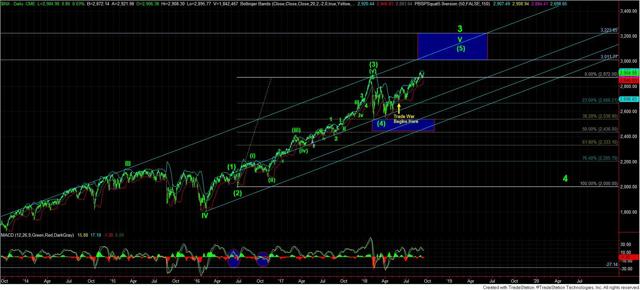-- Published: Monday, 17 September 2018 | Print | Disqus
By Avi Gilburt
This week, I am going to bring back the list of reasons that have been paraded before you over the last three-plus years as to why the stock market rally is over:
Brexit – NOPE
Frexit – NOPE
Grexit - NOPE
Italian referendum - NOPE
Rise in interest rates - NOPE
Cessation of QE - NOPE
Terrorist attacks - NOPE
Crimea – NOPE
Trump – NOPE
Market not trading on fundamentals – NOPE
Low volatility – NOPE
Record-high margin debt – NOPE
Hindenburg omens - NOPE
Syrian missile attack - NOPE
North Korea – NOPE
Record hurricane damage in Houston, Florida, and Puerto Rico - NOPE
Spanish referendum – NOPE
Las Vegas attack - NOPE
New York terrorist attack – NOPE (market even rallied strongly)
If we adopt the exogenous causation theory proposed by the analysts that expected these events to cause a stock market crash, then it leads us to the exact opposite conclusion: these events “caused” a 50% rally in the stock market during the last three-plus years.
Many of you are shaking your heads right now, thinking my point simply preposterous. If you think about it, that means you are willing to accept this exogenous causation theory when the narrative fits the facts, but ignore it when it does not. But, if you are consistent in your analysis, then you must come to the same conclusion I noted above. Otherwise, your analysis is simply faulty. I clearly adopt the latter perspective. We will address this again below.
As I do from time to time, I read some of the articles out there from authors who have been bearish for years, as I always wonder if they will turn bullish as we approach a market high of significance. With some of them, you see hints of bullishness beginning to seep into their analysis of late, whereas others will always be bearish. But, the one thing they all have in common is that they have all used the items in the list posted above as the latest and greatest reasons they will be proven right in their bearish assumptions, even though the market has rallied over 50% against their expectations.
The latest and greatest reason that the market will crash is the current trade war. In fact, one such bearish author, who has remained staunchly bearish for years, wrote this recently:
“The trade war could bring down the U.S. stock market in so many ways. It could further hit emerging market economies and cause global contagion and recession. China could further devalue the yuan . . . China could sell Treasuries or announce their true, and massively understated, Gold holdings. Tariffs could impact American companies’ costs and, therefore, their earnings. They could also cause a spike in consumer inflation and higher interest rates and yields, hurting consumer spending and increasing consumer debt defaults.”
We often chide economists for living in ivory towers while applying their lab-based economic theories which ultimately do not work in the real world. I wonder why we do not do the same with analysts. Let me show you what I mean:

If one simply looked at the daily chart of the stock market, and continued to apply the same exogenous causation theory being espoused by these bearish analysts, one would have to come to the exact opposite conclusion from that of the bearish analysts. As you can see, the more appropriate title for articles should be “Trade Wars Have Caused A Stock Market Rally.” In fact, we have rallied approximately 8% since the trade wars have begun.
But, these analysts remain the Foghorn Leghorn of the financial world:
“Don’t bother me with facts, son. I’ve already made up my mind.”

Foghorn Leghorn from Warner Brothers
Those who read my analysis know that I believe the market is rising because of trade wars to the same extent as I believe the market will fall based upon trade wars. Yes, the market will eventually drop. And, these same pundits will certainly tie the drop to the news of the day. But, please recognize the difference between causation and correlation, as they are not the same thing.
And, if I may, I want to remind you of the example regarding my children:
This reminds me of when my children were 3 years old, and we were stopped at a traffic light. They look at the traffic light, and say “now,” as they try to time the light changing back to green. And, if it does not change, they again say “now.” And, this goes on for maybe another 10 to 15 times, depending on how long the light takes to change. Yet, when the light finally changes at one of their “now’s,” they proudly assume that they caught that timing ever so perfectly.
This sure sounds like most of the pundits we read and listen to, does it not? So, yes, when I read these pundits providing us reason after reason as to why the market will top, I view it as akin to my 3-year-old child saying “now.” Eventually, the market will turn just like the traffic light will eventually turn and they will react just as proudly as my 3-year-old, assuming they caught that timing ever so perfectly. But, clearly there is no prescience to their abilities to identify the cause of that turn, just like my 3-year-old.
You see, just like my 3-year-old does not comprehend that there is something internal to the traffic light that causes the light to change, the pundits do not comprehend that there is something internal to the stock market that will eventually make it turn down. This is clearly evidenced by the fact that none of the exogenous events to which they have been pointing for years have been able to cause the turn to the stock market every time they say “now.” My 3-year-old and the market pundit simply do not comprehend the true driver of that which they are attempting to time.
I hope these narratives at least open your mind to the fact that daily banter about the market rising or falling based upon some news of the day is really meaningless. You have to learn to tune out the noise and focus on what matters most to the market in order to be able to maintain on the correct side of the market the great majority of the time.
What matters most at this point is support. Currently, my major support resides at 2830SPX. As long as we hold over that major support, my next target is in the 2980SPX region. I will be moving this support up to 2922 at a certain point, which I have outlined to the in my last weekend report.
My long-term expectations remain the same. For years, I have had a minimum target of 3011, with an ideal target of 3225. As long as support holds (and we will continue to raise that support should we continue higher), then I have every expectation that my targets will be met. But, I also have to remind you that, while I have been a staunch bull for years despite all the negative news that has bombarded the market, I am getting closer and closer to turning neutral, or even outright bearish, especially as we approach our long-term targets, or if we break our support. This is really all that matters in order to keep you on the right side of this market. Everything else is simply noise.
See charts illustrating the wave counts on the S&P 500.
Avi Gilburt is a widely followed Elliott Wave technical analyst and founder of ElliottWaveTrader.net (www.elliottwavetrader.net), a live Trading Room featuring his intraday market analysis (including emini S&P 500, metals, oil, USD & VXX), interactive member-analyst forum, and detailed library of Elliott Wave education.
| Digg This Article
-- Published: Monday, 17 September 2018 | E-Mail | Print | Source: GoldSeek.com

